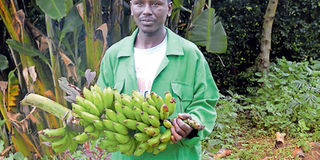Why you may never feast on the tasty sweet bananas again

Salesio Mung’athia displays a diseased sweet banana bunch in his farm in Meru. The disease wiping out the crop in the region is called Fusarium wilt and it affects both the sweet banana and the Kampala variety. PHOTO | CAROLINE WAMBUI | NMG
What you need to know:
- Sweet banana is distinguished for its uniquely small size, fine texture, a good aroma and exceptional taste.
- Sweet banana has fibre that makes it a good remedy for indigestion and has low cholesterol, thus good for the heart.
- During dry seasons, he recounts that ants also attacked the crop from the roots completely destroying them.
- Benard Kinoti, an extension officer in Mitunguu, Meru County, says the disease wiping out the crop is called Fusarium wilt and it affects both the sweet banana and the Kampala variety.
Sweet bananas are the most-sought after varieties of the fruit in the market, thus, fetching a premium price for growers.
But you may soon not be able to enjoy this fruit because of diseases that are making many farmers abandon the crop.
Sweet banana is distinguished for its uniquely small size, fine texture, a good aroma and exceptional taste.
The fruit has numerous health benefits that include offering a considerable amount of vitamins C and A. Its high levels of iron are key in strengthening bones and improving immunity.
Sweet banana has fibre that makes it a good remedy for indigestion and has low cholesterol, thus good for the heart.
The bananas have countless uses.
They can be used in desserts because the ripe ones are quite soft and don’t disintegrate easily into crumbs.
In markets across the country, they fetch at least Sh50 for a small bunch.
Salesio Mung’athia, 32, a farmer in Muthara location, Tigania East, Meru County, has been growing the crop for three years, but has made up his mind to stop farming it.
“I have been growing 450 plants on two acres, in a spacing of between 6ft and 8ft from one crop to the other. The holes should be 3 feet deep filled with manure and harvesting starts after about a year,” he says.
His lucrative agribusiness has faced headwinds following an outbreak of diseases.
“My sweet banana trunks started rotting from inside, right from the roots with the leaves turning yellow, then withering and drying. It happened so fast sometime in April, affecting and wiping out my entire plantation,” he says.
It was a double tragedy for Mung’athia as the trunks and the leaves of the infected crops could also not be fed to livestock.
During dry seasons, he recounts that ants also attacked the crop from the roots completely destroying them.
DIFFICULT TO MANAGE
“I was unable to get help from the county’s Ministry of Agriculture. All I received were unfulfilled promises of inspection,” he says.
Oscar Gitonga, 28, a farmer in Rwompo village in Mitunguu Meru, who farms the Williams variety on 30 acres, says he stopped growing the sweet banana because of many challenges.
“Banana plants require less labour input and capital and has a ready market in the region but investing in sweet bananas is not economical as once the disease strikes, the entire plantation is wiped out leaving the farmer staring at losses,” Gitonga explains.
Gerald Gicheru, a retired civil servant who turned to farming bananas and mangoes on his 25 acres in Itugururu, Tharaka Nithi County, says he tried the sweet banana variety on large-scale and gave up after the fruit was wiped out by diseases.
Benard Kinoti, an extension officer in Mitunguu, Meru County, says the disease wiping out the crop is called Fusarium wilt and it affects both the sweet banana and the Kampala variety.
“The sweet banana is the worst affected as it doesn’t have the improved varieties which farmers can grow. The local varieties being grown succumb to the disease easily.”
The disease, he says, invades the roots, and the stem, blocking water from reaching the whole plant thus causing the leaves to dry and collapse. It is spread through contaminated planting medium.
Kinoti adds that there is no cure or control measure for Fusarium wilt.
“It is a very difficult disease to manage as the fungus stays in the soil for many years. No cultural method or fungicides can be effectively applied to contain it.”
He advises that farmers should ensure that they plant clean, disease-free materials and practice hygiene measures on the farm.





